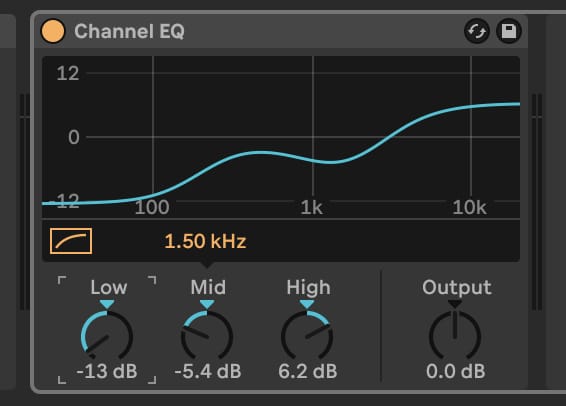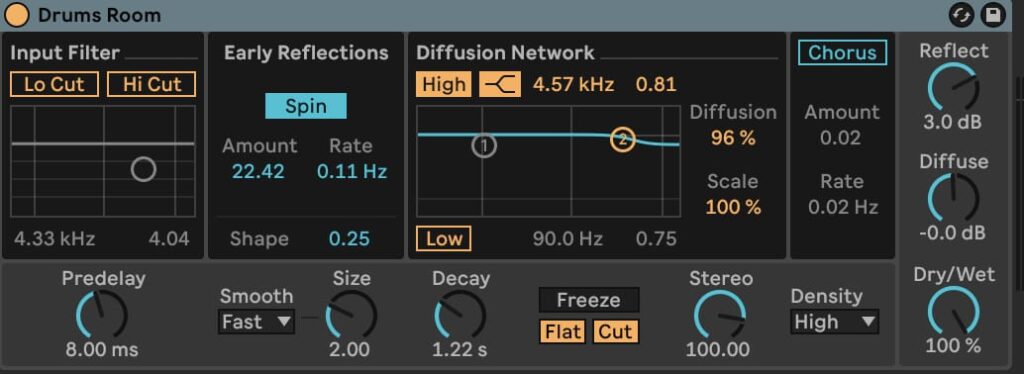February 25 Update: The college noticed that I hadn’t fully resolved the jazz gig and the mixing/mastering tasks. Before the holidays began, I took the initiative to complete the required work and gathered some evidence of my accomplishments.
Firstly, I worked with the channel EQ. I will outline what I needed to master and the program I used, which caused me some minor hassles. I had a 15-minute gig to master, consisting of four songs of varying lengths, along with instrumentals and crowd noise. I used Ableton Live 12 Suite for this process. While I would have preferred to use Logic for live sound mastering initially, the foundational skills Lewis and Evan taught me helped me navigate the work efficiently.
Below is a screenshot of the channel EQ I initially used. However, I later switched to a more advanced EQ that provided more than three sliders, allowing me to eliminate unwanted frequencies from the tracks I was working on.
I had to manage three drum tracks: the kick and two overheads. In addition, there were two guitars and two vocal tracks, along with a bass guitar track. This lineup was fairly manageable, though the trumpet featured in the third, entirely instrumental song posed a challenge. I struggled to boost its sound as I was unsure which microphone was capturing it.


I also added reverb to the drums. Initially, I didn’t think the drums needed much reverb, but after making minor adjustments, I found it helpful in creating a fuller, more satisfying effect. This addition complemented the funkier bass, uplifting the overall mood. A drier mastering of the drums would have felt lackluster, for lack of a better term. I kept the decay and delay to a minimum, as only slight amounts were needed to reach a satisfactory level.

Here are the final levels of the respective tracks in order: Kick, Overhead 1, Overhead 2, Bass, Guitar 1, Guitar 2, Vox 1, Vox 2. I made slight panning adjustments for the stereo mix to create a more spacious listening experience. Achieving a true ‘live gig’ feel through Dolby ATMOS is challenging, especially since it isn’t widely accessible to most producers yet. At college, we lack the necessary tools for this type of audio mastering, so I settled for left and right panning. This raises the question: does mixing/mastering for ATMOS automatically convert when played on stereo speakers? We would need multiple speakers to test ATMOS-mastered audio accurately.
Overall, I am satisfied with this mix and master, completed in a day, and I hope to take on similar projects in the future. Unfortunately, I cannot post the audio at this time, as the Digitalspace website cannot handle tracks over 200 MB. Even when compressed to 20 MB, it still struggles. I plan to address this issue when I return to college after the holidays.
Problem Solving
I think the fact that I got this project finished shows off some off my problem solving skills. Despite of my attendance, which was affected by things happening outside of college, I had just enough initiative to get this project over the line. The jazz part of the project in particular had to be entirely organized by me, which shows initiative. I have contacted the technician and we worked on that part of the module together. Mixing is something I’m relatively good at but not as good or fluent as I am where it comes to production. I had to to a significant amount of reading to get the mix to sound the way I wanted it to. I have also tried and managed partially to connect some college equipment using ethernet connection, although that only happened thanks to Evan’s help ultimately. I think that pushing through difficult patches is important, and this definitely was one of them. I wish I attended the sessions instead, but I can’t change that. I hope that the final outcome is sufficient to pass the module.